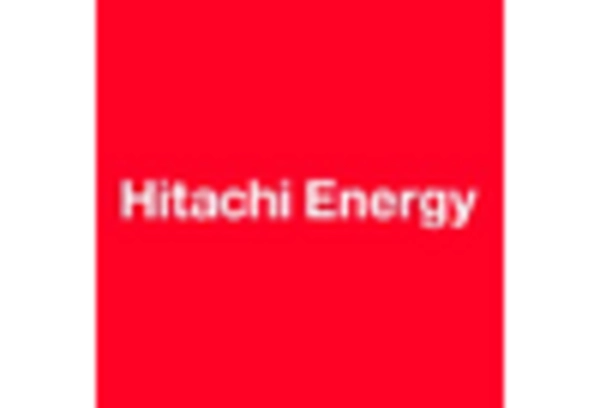Rising Demand for Renewable Energy
The increasing emphasis on renewable energy sources is a pivotal driver for the High Voltage Substation Market. As nations strive to meet ambitious carbon reduction targets, the integration of renewable energy into the grid becomes essential. High voltage substations play a crucial role in facilitating this transition by enabling the efficient transmission of electricity generated from wind, solar, and hydroelectric sources. According to recent data, the share of renewables in the energy mix is projected to reach 50% by 2030, necessitating the expansion and modernization of substations to handle the fluctuating nature of renewable energy. This trend not only supports energy security but also enhances grid resilience, thereby propelling the growth of the High Voltage Substation Market.
Urbanization and Infrastructure Development
Rapid urbanization and infrastructure development are significant contributors to the High Voltage Substation Market. As urban populations swell, the demand for reliable electricity supply intensifies, prompting investments in high voltage substations to ensure adequate power distribution. In many regions, urban areas are experiencing a surge in construction projects, including residential, commercial, and industrial developments. This surge necessitates the establishment of robust electrical infrastructure, with high voltage substations serving as critical nodes in the power distribution network. Data indicates that urban areas are expected to account for over 70% of global energy consumption by 2030, underscoring the urgent need for enhanced substation capabilities to meet this demand.
Government Initiatives and Regulatory Support
Government initiatives and regulatory support are instrumental in shaping the High Voltage Substation Market. Many governments are implementing policies aimed at modernizing electrical infrastructure to accommodate the growing demand for electricity. Incentives for renewable energy projects and funding for infrastructure upgrades are becoming increasingly common. For instance, regulatory frameworks that promote public-private partnerships are facilitating investments in high voltage substations, ensuring that they meet contemporary standards for safety and efficiency. As regulatory bodies continue to prioritize energy security and sustainability, the High Voltage Substation Market is likely to experience accelerated growth driven by these supportive measures.
Technological Advancements in Substation Design
Technological advancements in substation design and operation are reshaping the High Voltage Substation Market. Innovations such as digital substations, which utilize advanced sensors and automation technologies, enhance operational efficiency and reliability. These advancements allow for real-time monitoring and predictive maintenance, reducing downtime and operational costs. Furthermore, the adoption of smart grid technologies is facilitating better integration of distributed energy resources, thereby optimizing the performance of high voltage substations. As the market evolves, it is anticipated that the implementation of these technologies will lead to a more resilient and efficient power grid, driving further investments in the High Voltage Substation Market.
Increased Investment in Energy Storage Solutions
The rising investment in energy storage solutions is emerging as a key driver for the High Voltage Substation Market. As the integration of renewable energy sources increases, the need for effective energy storage systems becomes paramount to balance supply and demand. High voltage substations are essential for connecting these storage systems to the grid, enabling the efficient distribution of stored energy during peak demand periods. Recent estimates suggest that the energy storage market could reach USD 620 billion by 2030, highlighting the potential for high voltage substations to play a critical role in this evolving landscape. This trend not only enhances grid stability but also supports the broader transition towards a more sustainable energy future.


















Leave a Comment